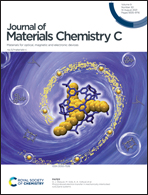Highly phosphorescent platinum(ii) complexes supported by (2-(1H-benzimidazole)-phenyl)diphosphine oxide ancillary ligands†
Abstract
Novel luminescent cycloplatinated(II) complexes (ppy–Pt–L, L = deprotonated (2-(1H-benzimidazole)-phenyl)diphenylphosphine oxide derivatives) have been synthesized. The crystal structures of the complexes display slightly distorted square-planar geometries around platinum(II) centers. There are no obvious π–π stacking interactions and Pt–Pt interactions in the crystal lattice due to the presence of sterically bulky benzimidazole phosphine oxygen ancillary ligands. As a result, the ppy–Pt–L complexes show structured monomeric emissions with the highest photoluminescence quantum yields of up to 86.1% and 64.2% in solution and in powder, respectively. The structured emissions coupled with microsecond radiative lifetimes and the support of DFT calculations reveal that the emissions of ppy–Pt–L complexes mainly originate from the 3IL state with some mixing of the 3MLCT excited state. The device with ppy–Pt–L3 as an emitter exhibits high electroluminescence performance with a maximal external quantum efficiency (EQEmax) of 21.1%, which is among the highest EQEs reported for OLEDs using heteroleptic platinum(II) complexes based on ppy derivatives. The results suggested that these ppy–Pt–L complexes containing bulky benzimidazole phosphine oxygen ancillary ligands have potential applications in realizing efficient OLEDs.



 Please wait while we load your content...
Please wait while we load your content...